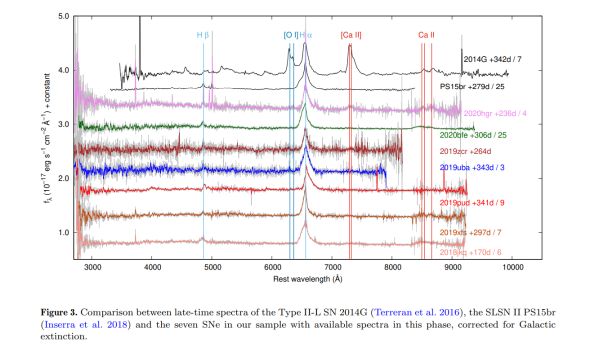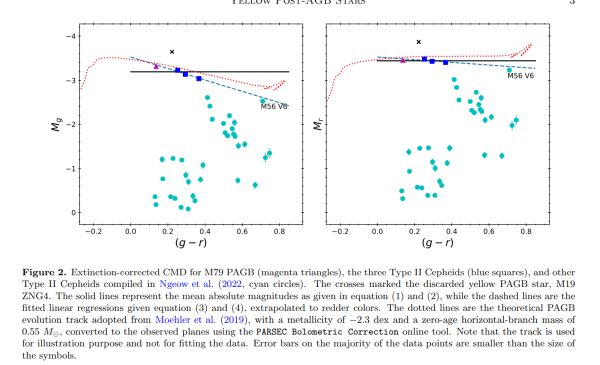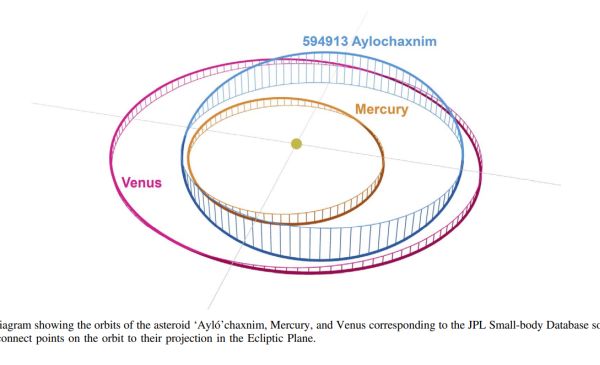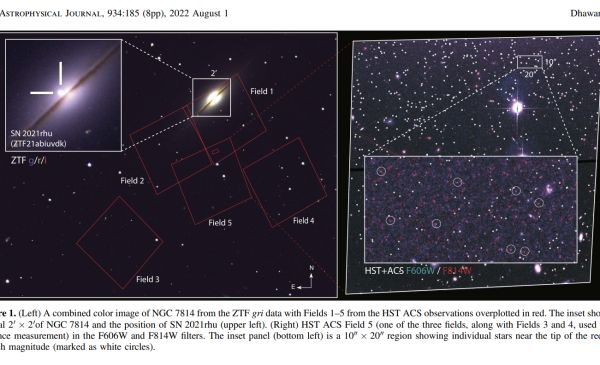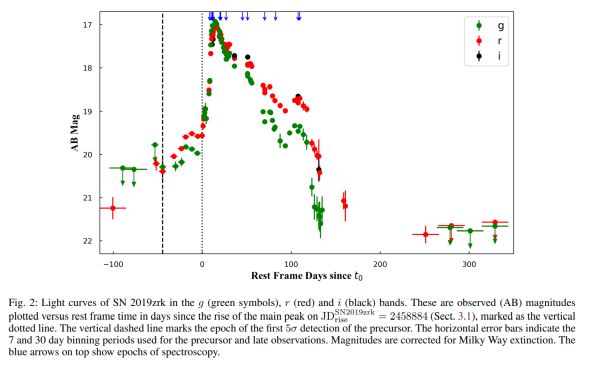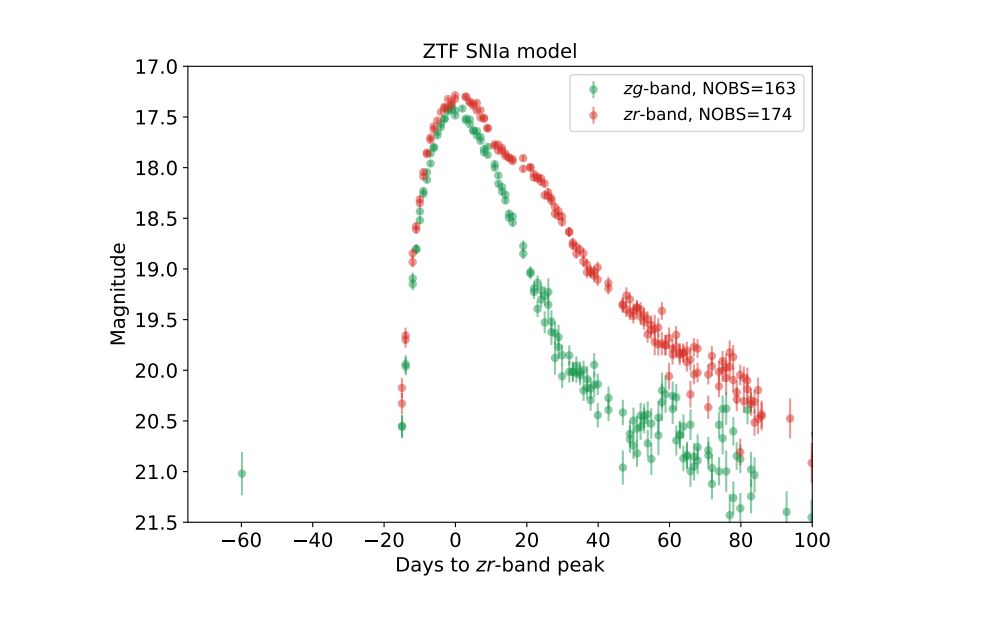ZTF Public Data Release 13
The Zwicky Transient Facility (ZTF) and IPAC at the California Institute of Technology announce the thirteenth ZTF Public Data Release. This release adds 2 months of observations to the twelfth data release, up to 8 July 2022 for the public portion of the survey, and private survey time prior to 7 March 2021.
The products include 41.7 million single-exposure images, 167 thousand co-added images, accompanying source catalog files containing 671 billion source detections extracted from those images, and 4.37 billion light curves constructed from the single-exposure extractions.
Science Highlights
Superluminous supernovae in Phase I of ZTF
Authors present a sample of 14 hydrogen-rich superluminous supernovae (SLSNe II) from the Zwicky Transient Facility (ZTF) between 2018 and 2020. They include all classified SLSNe with peaks Mg less than -20 mag and with observed broad but not narrow Balmer emission, corresponding to roughly 20 per cent of all hydrogen-rich SLSNe in ZTF phase I. Authors also examine the light curves and spectra of SLSNe II and attempt to constrain their power source using light-curve models.
Zwicky Transient Facility and Globular Clusters
The Zwicky Transient Facility and Globular Cluster project aimed to calibrate the old population distance indicators by using homogeneous light curves from ZTF and the latest distance determination to globular clusters from Baumgardt & Vasiliev (2021). These distance indicators include late-type contact binaries, RR Lyrae, Type II Cepheids, yellow post asymptotic-giant-branch (yPAGB) stars, and anomalous Cepheids. Except for RR Lyrae, the calibrations of other distance indicators were performed in the gr(i)-band for the first time. These gr(i)-band calibrated old population distance indicators have a great potential to be applied in the era of Rubin Observatory’ LSST, for example to determine distances to newly discovered dwarf galaxies. Results are presented in a series of three papers now published on ArXiv.
The asteroid floating in the orbit of Venus
ZTF partners in Taiwan report on the discovery by the Zwicky Transient Facility of an asteroid orbiting entirely within the orbit of Venus, the first known example of this orbital class. The asteroid's perihelion is closer to the Sun than the aphelion of Mercury, and its diameter is estimated at about 1.8 km assuming an albedo of 0.2. The object was first observed on 2020 January 4 in four exposures obtained 7 minutes apart during an evening twilight survey. Its IAU-recognized designation is 594913 'Ayló'chaxnim.
Foraging with MUSHROOMS
Authors present a new target-of-opportunity scheduling algorithm that uses mixed-integer linear programming and compare its performance to gwemopt, the tuned \heuristic scheduler used by the ZTF and other facilities during the third LIGO-Virgo gravitational-wave observing run. This new algorithm uses variable-length observing blocks to enforce cadence requirements and to ensure field observability, along with having a secondary optimization step to minimize slew time. Results show that by employing a hybrid method utilizing both this scheduler and gwemopt, the previous scheduler used, in concert, there is an average improvement in detection efficiency of 3%-11% over gwemopt alone for a simulated binary neutron star merger data set consistent with LIGO-Virgo's third observing run.
A uniform distance ladder with ZTF
Lead author Suhail Dhawan (Cambridge University) and co-authors propose a uniform distance ladder between the second and third rungs, combining Type Ia supernovae (SNe Ia) observed by the Zwicky Transient Facility (ZTF) with a TRGB calibration of their absolute luminosity. A large, volume-limited sample of both calibrator and Hubble flow SNe Ia from the same survey minimizes two of the largest sources of systematic uncertainties in local measurements to understand the Hubble tension: host-galaxy bias and nonuniform photometric calibration. They present results from a pilot study using the existing TRGB distance to the host galaxy of ZTF SN Ia SN 2021rhu (aka ZTF21abiuvdk) in NGC7814.
The discovery of SN 2019zrk
ZTF partners from the University of Stockholm present photometric and spectroscopic observations of the Type IIn supernova SN 2019zrk. SN2019zrk was found to exhibits strong similarities with SN 2009ip and similar SNe. Different scenarios for the nature of the 09ip-class of SNe, based on pulsational pair instability eruptions, wave heating, and mergers, are also discussed in the paper.
ZTF Faces
Steve Schulze
(OKC, Stockholm University, Sweden)
My path has been circuitous, like for many other astronomers. I was born and raised in Halle, Germany, the hometown of the Baroque composer Georg Friedrich Händel.
Read OnGeorgios Dimitriadis
(Trinity College Dublin, Ireland)
I was born in a small city in north-east Greece called Xanthi. My parents bought me a small toy telescope when I was 7 years old. This was followed by several books and documentaries about astronomy and space.
Read OnScience with public ZTF data
We highlight scientific publications from individuals and groups outside of the ZTF partnership that use ZTF public data
SNAD transient miner: Finding missed transient events in ZTF DR4 using k-D trees
New astronomical surveys allow us to probe different epochs and regions of the Universe. At the same time, every new data set is more complex and bigger than its precedents. In the absence of carefully designed unsupervised learning pipelines, we may miss discoveries which are in the root of all scientific endeavours. The SNAD miner is a fast, and robust algorithm which uses simulated light-curves as guides for specific class searches. Its first application to ZTF data resulted in the discovery of 11 non-catalogued transients. Since then, it has already been used to identified more than a hundred new candidates. We plan to apply it to more recent data to better understand how the fraction of non-reported transients evolves with the development of the survey. This will help prevent similar losses in upcoming data sets.This understanding is an important step towards an optimal exploitation of our observational resources.
--Konstantin Malanchev (University of Illinois at Urbana-Champaign)
'How-to' Guide
IRSA Time Series Tool
Have you check the IRSA Time Series Tool? The Time Series Tool allows exploration and analysis of time series observations. For ZTF, you can view measurements as a function of time, simultaneously visualize the single-epoch images, and optionally find the period of variability. Get a quick glance at the documentation and start playing around.
Time Series ToolOutreach
ZTF summer school welcomes 80 students from around the world
The ZTF summer school took place in late July on the campus of the University of Minnesota, Twin Cities. The hybrid more allow many students from around the world to join in as well. Listen to lead organizer Michael Coughlin (assistant professor at the UMN) in this video who shares impressions from the summer school. As always, the materials from the school are made freely available to anyone on our website.
Watch Lectures Download Python Notebooks
ZTF is supported by the National Science Foundation and a collaboration including Caltech, IPAC, the
Weizmann Institute for Science, the Oskar Klein Center at Stockholm University, the University of
Maryland, Deutsches Elektronen-Synchrotron and Humboldt University, Lawrence Livermore National
Laboratory, the TANGO Consortium of Taiwan, the University of Wisconsin at Milwaukee, Trinity College
Dublin, IN2P3, University of Warwick, Ruhr University Bochum, and Northwestern University . Operations are conducted
by COO, IPAC and University of Washington.
Any opinions, findings, and conclusions or recommendations expressed in this material are those of the
author(s) and do not necessarily reflect the views of the National Science Foundation.
